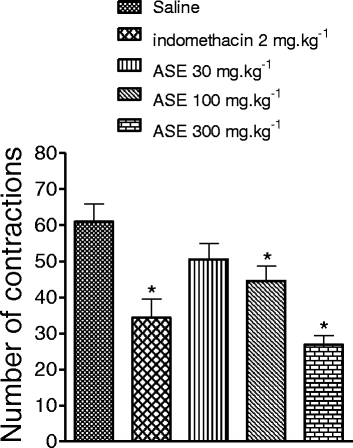Antinociceptive effects of hydroalcoholic extract from Euterpe oleracea Mart. (Açaí) in a rodent model of acute and neuropathic pain
- PMID: 26134625
- PMCID: PMC4489033
- DOI: 10.1186/s12906-015-0724-2
Antinociceptive effects of hydroalcoholic extract from Euterpe oleracea Mart. (Açaí) in a rodent model of acute and neuropathic pain
Abstract
Background: Plants rich in flavonoids, such as açaí (Euterpe oleraceae Mart.), can induce antinociception in experimental animals. Here, we tested an extract obtained from the stones of açaí fruits (açaí stone extract, ASE), a native plant from the Amazon region of Brazil, in models of acute/inflammatory and chronic pain.
Methods: Antinociceptive effects of ASE were evaluated in the hot plate, formalin, acetic acid writhing, carrageenan, and neuropathic pain models, as well as in thermal hyperalgesia and mechanical allodynia models induced by spinal nerve ligation. Antinociceptive activities were modulated by the administration of cholinergic, adrenergic, opioid, and L-arginine-NO antagonists.
Results: Oral administration of ASE (30, 100, or 300 mg.kg(-1)) dose-dependently reduced nociceptive responses to acute/inflammatory pain in mice, including thermal hyperalgesia, acetic acid-induced writhing, and carrageenan-induced thermal hyperalgesia. Moreover, ASE reduced the neurogenic and inflammatory phases after intraplantar injection of formalin in mice. The antinociceptive effect of ASE (100 mg · kg(-1)) in a hot plate protocol, was inhibited by pre-treatment with naloxone (1 mg · kg(-1)), atropine (2 mg · kg(-1)), yohimbine (5 mg · kg(-1)), or L-NAME (30 mg · kg(-1)). Furthermore, ASE prevented chronic pain in a rat spinal nerve ligation model, including thermal hyperalgesia and mechanical allodynia.
Conclusion: ASE showed significant antinociceptive effect via a multifactorial mechanism of action, indicating that the extract may be useful in the development of new analgesic drugs.
Figures





Similar articles
-
Euterpe oleracea Mart. (Açaí) attenuates experimental colitis in rats: involvement of TLR4/COX-2/NF-ĸB.Inflammopharmacology. 2021 Feb;29(1):193-204. doi: 10.1007/s10787-020-00763-x. Epub 2020 Sep 29. Inflammopharmacology. 2021. PMID: 32996043
-
Antinociceptive properties of the hydroalcoholic extract and the flavonoid rutin obtained from Polygala paniculata L. in mice.Basic Clin Pharmacol Toxicol. 2009 Apr;104(4):306-15. doi: 10.1111/j.1742-7843.2008.00365.x. Epub 2009 Mar 5. Basic Clin Pharmacol Toxicol. 2009. PMID: 19281602
-
Antinociceptive effect of hydroalcoholic extract and isoflavone isolated from Polygala molluginifolia in mice: evidence for the involvement of opioid receptors and TRPV1 and TRPA1 channels.Phytomedicine. 2016 May 15;23(5):429-40. doi: 10.1016/j.phymed.2016.02.002. Epub 2016 Mar 2. Phytomedicine. 2016. PMID: 27064002
-
The Use of Euterpe oleracea Mart. As a New Perspective for Disease Treatment and Prevention.Biomolecules. 2020 May 26;10(6):813. doi: 10.3390/biom10060813. Biomolecules. 2020. PMID: 32466439 Free PMC article. Review.
-
What we know about açaí by-products and topical formulations: A review.Int J Pharm. 2025 Jul 25;680:125732. doi: 10.1016/j.ijpharm.2025.125732. Epub 2025 May 15. Int J Pharm. 2025. PMID: 40381669 Review.
Cited by
-
Antioxidant and Hypolipidemic Activity of Açai Fruit Makes It a Valuable Functional Food.Antioxidants (Basel). 2020 Dec 31;10(1):40. doi: 10.3390/antiox10010040. Antioxidants (Basel). 2020. PMID: 33396456 Free PMC article.
-
Analgesic effects of Marasmius androsaceus mycelia ethanol extract and possible mechanisms in mice.Braz J Med Biol Res. 2018 Mar 1;51(4):e7124. doi: 10.1590/1414-431X20177124. Braz J Med Biol Res. 2018. PMID: 29513798 Free PMC article.
-
Euterpe oleracea Extract (Açaí) Is a Promising Novel Pharmacological Therapeutic Treatment for Experimental Endometriosis.PLoS One. 2016 Nov 16;11(11):e0166059. doi: 10.1371/journal.pone.0166059. eCollection 2016. PLoS One. 2016. PMID: 27851787 Free PMC article.
-
Euterpe oleracea extract (açaí) exhibits cardioprotective effects after chemotherapy treatment in a breast cancer model.BMC Complement Med Ther. 2023 Aug 25;23(1):301. doi: 10.1186/s12906-023-04104-7. BMC Complement Med Ther. 2023. PMID: 37626388 Free PMC article.
-
Euterpe oleracea extract inhibits tumorigenesis effect of the chemical carcinogen DMBA in breast experimental cancer.BMC Complement Altern Med. 2018 Apr 2;18(1):116. doi: 10.1186/s12906-018-2183-z. BMC Complement Altern Med. 2018. PMID: 29609579 Free PMC article.
References
-
- Begossi A, Hanazaki N, Tamashiro JY. Medicinal plants in the Atlantic forest (brazil): knowledge, Use and conservation. Hum Ecol. 2002;30(3):281–99. doi: 10.1023/A:1016564217719. - DOI
-
- Scudeller VV, Veiga JB, Araújo Jorge LH. In: Etnoconhecimento de plantas de uso medicinal nas comunidades São joão do tupé e central (reserva de desenvolvimento sustentável do tupé), in biotupé - meio físico, diversidade biológica e sociocultural do baixo Rio negro, amazônia central. Santos-Silva EN, Scudeller VV, editors. UEA Edições: Nanaus; 2009. pp. 185–99.
-
- Pacheco-Palencia LA, Duncan CE, Talcott ST. Phytochemical composition and thermal stability of two commercial açaí species, Euterpe oleracea and Euterpe precatoria. Food Chem. 2009;115(4):1199–205. doi: 10.1016/j.foodchem.2009.01.034. - DOI
-
- Rocha APM, Carvalho LC, Sousa MA, Madeira SV, Sousa PJ, Tano T, Schini-Kerth VB, Resende AC, Soares De Moura R. Endothelium-dependent vasodilator effect of Euterpe oleracea Mart. Açaí extracts in mesenteric vascular bed of the rat. Vascul Pharmacol. 2007;46(2):97–104. doi: 10.1016/j.vph.2006.08.411. - DOI - PubMed
Publication types
MeSH terms
Substances
LinkOut - more resources
Full Text Sources
Other Literature Sources

